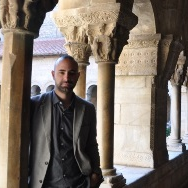Byzantium and the Mediterranean (11th–13th C.): Multiculturalism, Gender and Profane Topics in Illuminated Manuscripts
A special issue of Arts (ISSN 2076-0752). This special issue belongs to the section "Visual Arts".
Deadline for manuscript submissions: closed (27 February 2023) | Viewed by 9379
Special Issue Editors
Interests: visual arts from antiquity to c. 1500; medieval artist; Byzantine art; Romanesque art; artistic transfer and mobility; patronage; pilgrimage; Mediterranean studies
Special Issues, Collections and Topics in MDPI journals
Interests: medieval artists; Romanesque sculpture; Romanesque painting; building construction; late antiquity; sociology of arts
Special Issues, Collections and Topics in MDPI journals
Interests: byzantine art; cultural exchange; medieval mediterranean; illuminated manuscripts; gender
Special Issue Information
Dear Colleagues,
Byzantine illuminated manuscripts constitute a fascinating field of study to be explored in terms of cross-cultural exchanges, gender issues and the spreading of profane topics. This phenomenon was especially rich in the turmoil of 12th and 13th century art in the Mediterranean as a privileged space for interchanging between Latins, Greeks and Muslims. The prestige of Constantinople, the continuity of deep-rooted Byzantine artistic traditions in most of the areas of the Mediterranean (Sicily, Venice, Cyprus, Crusader States, etc), and the increasing mobility of artists, models, and codices fostered these kinds of artistic encounters.
Some of the Byzantine codices from this period—chronicles, manuals of poliorcetics, cynegetic treatise or even biblical and ecclesiastical manuscripts—provide us precious information related to customs, ceremonies, warfare techniques, buildings, clothing, social strata and ethnic and cultural diversity.
We invite articles concerning these topics, especially those regarding gender roles, the depiction of Otherness, the use and meaning of profane repertoires in manuscripts and their spreading and impact on other visual arts.
Proposals for papers of up to max 15.000 words in length should be sent to the guest editors, Manuel Castiñeiras, on manuel.castineiras@uab.cat, and Carles Sánchez Márquz, on carlos.sanchez.marquez@uab.cat, by 31 October, 2022. Papers should be in English.
Prof. Dr. Manuel Castiñeiras
Prof. Dr. Carles Sánchez Márquez
Dr. Verónica Abenza
Guest Editors
Manuscript Submission Information
Manuscripts should be submitted online at www.mdpi.com by registering and logging in to this website. Once you are registered, click here to go to the submission form. Manuscripts can be submitted until the deadline. All submissions that pass pre-check are peer-reviewed. Accepted papers will be published continuously in the journal (as soon as accepted) and will be listed together on the special issue website. Research articles, review articles as well as short communications are invited. For planned papers, a title and short abstract (about 100 words) can be sent to the Editorial Office for announcement on this website.
Submitted manuscripts should not have been published previously, nor be under consideration for publication elsewhere (except conference proceedings papers). All manuscripts are thoroughly refereed through a double-blind peer-review process. A guide for authors and other relevant information for submission of manuscripts is available on the Instructions for Authors page. Arts is an international peer-reviewed open access semimonthly journal published by MDPI.
Please visit the Instructions for Authors page before submitting a manuscript. The Article Processing Charge (APC) for publication in this open access journal is 1400 CHF (Swiss Francs). Submitted papers should be well formatted and use good English. Authors may use MDPI's English editing service prior to publication or during author revisions.
Keywords
- Byzantine illuminated manuscripts
- 12th and 13th century art in the Mediterranean
- cross-cultural studies
- profane repertoires
- gender






